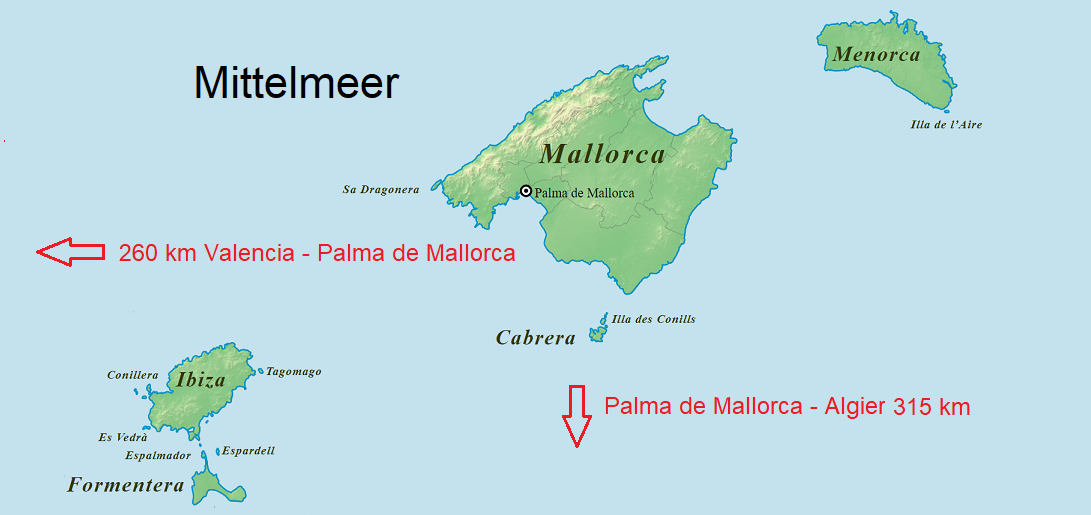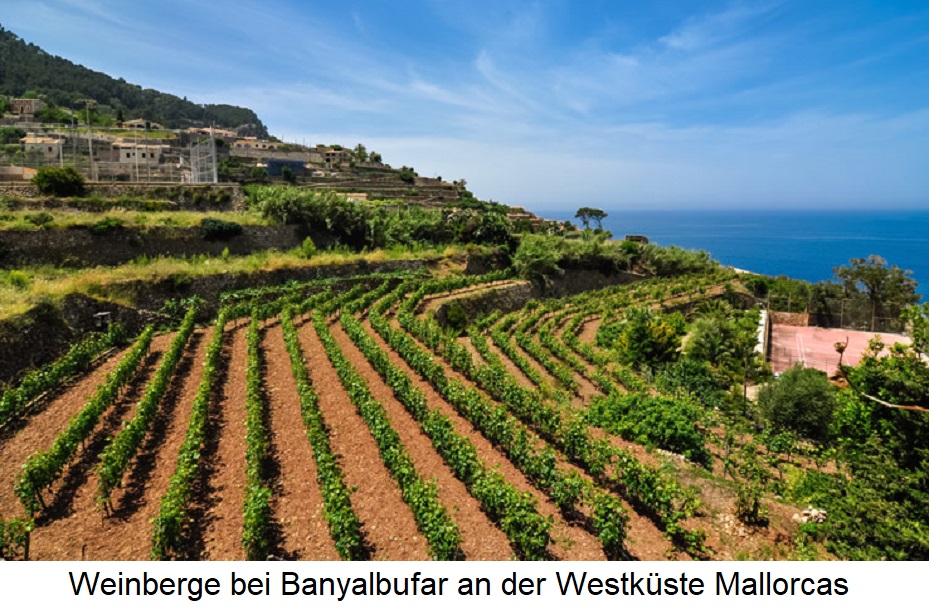The autonomous region of the Balearic Islands (Catalan: Illes Balears, Spanish: Islas Baleares), which belongs to Spain and has its capital in Palma (on Mallorca), covers a total of 4,992 km² and is located in the western Mediterranean. The archipelago includes the five main inhabited islands of Mallorca (3,604 km²), Menorca (695 km²), Cabrera (16 km²), Ibiza (572 km²) and Formentera (83 km²). There are also 146 uninhabited islands, including the Dragonera and Pantaleu, which are protected rocky islands. The history has always been strongly linked to Catalonia, which is why Catalan is spoken there today (in addition to Castilian). The centre with Mallorca lies around 260 km east of the Spanish mainland near Valencia. It stretches 260 kilometres from west to east and 120 kilometres from north to south.

History
The Phoenicians probably brought viticulture to the Balearic Islands. Under Roman rule, wine was praised by Pliny the Elder (23-79). During the almost five centuries of Moorish rule from the 8th to the 12th century, viticulture only survived because dried grapes were a popular foodstuff due to their long shelf life. In 1221, Jaime I (1213-1276) conquered the islands and founded his own kingdom of Aragón (which also included the French Roussillon and Spanish Catalonia ), which lasted until 1343. During this time, wine from Mallorca was even supplied to the Spanish royal court in Madrid. In the 19th century, it was famous for its sweet Malvasia wines, which were equalled in quality by the Portuguese Madeira.

Climate & soils
There are around 300 days of sunshine a year on all the islands. The Mediterranean, frost-free climate is characterised by mostly humid, fairly mild winters and dry spells of over 40 °Celsius in summer, especially in the autumn months when there can be thunderstorms with heavy rainfall. The calcareous and, depending on the iron content, red or brown soils are relatively poor in nutrients. They are mostly based on sedimentary rocks such as marl and dolomite.
Vineyards & grape varieties
The vineyards cover 2,000 hectares of vines. At the beginning of the 19th century, it was around ten times larger. The phylloxera catastrophe at the end of the century put an abrupt end to this in just three years. Many former vineyards were planted with almond trees. The tourist boom from the beginning of the 1960s led to growing wine consumption. Red wines make up 44%, white wines 38% and Róse wines 18%. There are many indigenous grape varieties that have developed here.
The red wine varieties Cabernet Sauvignon, Callet, Callet Negrella, Epero de Gall, Escursac, Fogoneu, Girò, Gorgollasa, Grossa, Macabeo, Mansés de Tibbus, Manto Negro, Merlot, Monastrell, Sabaté, Syrah and Ull de Llebre or Cencibel (Tempranillo) are grown (often in very small quantities), as well as the white wine varieties Callet Cas Concos Blanco, Chardonnay, Giro Blanco, Giro Ros, Macabeo, Malvasia di Candia Aromatica, Malvasia de Banyalbufar (Malvasia di Lipari), Merseguera, Moll (Prensal), Moscatel de Grano Menudo (Muscat Blanc), Moscatel de Alejandría (Muscat d'Alexandrie), Parellada, Quigat and Viognier.
Wine-growing areas
Today, viticulture is concentrated on the largest island, Mallorca, and is less important on the other islands. There are two DO areas for quality wines (on Mallorca) and six IGP areas for country wines (IGP name and island/area):
- Binissalem - Mallorca (DO)
- Formentera - Formentera (IGP)
- Ibiza (formerly Eivissa) - Ibiza (IGP)
- Illes Baleares - entire region (IGP)
- Isla de Menorca - Menorca (IGP)
- Mallorca - Mallorca (IGP)
- Plà i Llevant - Mallorca (DO)
- Serra de Tramuntana-Costa Nord - Mallorca (IGP)
Producers
Well-known producers are Macíà Batle, Son Bordils, José L. Ferrer - Franja Roja, Florianopolis, Castell Miquel, Miquel Gelabert, Toni Gelabert, Can Majoral, Jaume Mesquida, Vins Nadal, Miquel Oliver, Hereus de Ribas, Pere Seda and Ca'n Vidalet.
Map: by NordNordWest, Own work, using OpenStreetMap, CC BY-SA 2.0, Link
edited by Norbert F.J. Tischelmayer - June 2020
Vineyards: Las Islas Reisen GmbH
Voices of our members

The glossary is a monumental achievement and one of the most important contributions to wine knowledge. Of all the encyclopaedias I use on the subject of wine, it is by far the most important. That was the case ten years ago and it hasn't changed since.
Andreas Essl
Autor, Modena